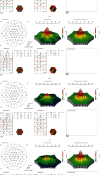Visual Sequelae of Computer Vision Syndrome: A Cross-Sectional Case-Control Study
- PMID: 33868724
- PMCID: PMC8035040
- DOI: 10.1155/2021/6630286
Visual Sequelae of Computer Vision Syndrome: A Cross-Sectional Case-Control Study
Abstract
Purpose: To assess the visual, ocular, extraocular, and multifocal electroretinography (mfERG) outcomes of computer vision syndrome (CVS) among medical students.
Methods: This study was designed as a cross-sectional case-control study that included 733 medical students. All students completed a specially designed and validated CVS questionnaire survey (CVS-F3). Students from the control (No-CVS) and CVS groups underwent comprehensive ophthalmic examinations including the mfERG examinations. Our main outcome measures included uncorrected and corrected distance visual acuity (UDVA and CDVA, resp.) measurements, subjective and cycloplegic refractions, slit-lamp examination, intraocular pressure measurement, pupillary reflexes tests, ocular movements' tests, dry eye disease tests, and fundus and mfERG examinations.
Results: The CVS-F3 identified that 87.9% of students had complaints that might be related to CVS. We documented a 76% prevalence rate in students undergoing an ophthalmologic exam. The most common ocular and extraocular complaints included visual blur and headache (40.9% and 46.8%, resp.). Statistical logistic and linear regression analyses showed that refractive errors, prolonged screen-hours, close eye-screen distance, improper gaze angle, poor screen-resolution, and screen-glare were risk factors for developing CVS and influencing its severity. In the mfERG subgroup, 42.5% demonstrated reduced amplitudes of mfERG rings and quadrants, indicating reduced foveal responses.
Conclusion: Surveys cannot yield an accurate CVS prevalence. However, they help to identify subjects at risk who should be comprehensively assessed to confirm or exclude CVS diagnosis. Smartphone misuse primarily caused CVS among users. Our mfERG findings might be a sign of potential CVS visual sequelae; however, future studies are warranted. Clinicians need to understand these sequelae to appropriately identify and treat CVS.
Copyright © 2021 Mohammed Iqbal et al.
Conflict of interest statement
The authors declare that there are no conflicts of interest regarding the publication of this paper.
Figures


References
-
- American Optometric Association. Computer vision syndrome. 2020. https://www.aoa.org/patients-and-public/caring-for-your-vision/protectin....
-
- Klamm J., Tarnow K. G. Computer vision syndrome: a review of literature. MEDSURG Nursing. 2015;24(2):89–93. - PubMed
LinkOut - more resources
Full Text Sources
Other Literature Sources
Medical
Miscellaneous

